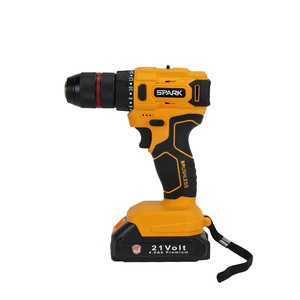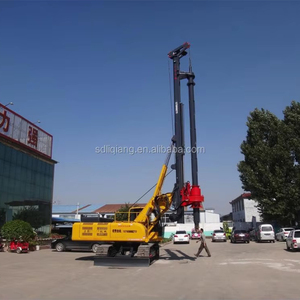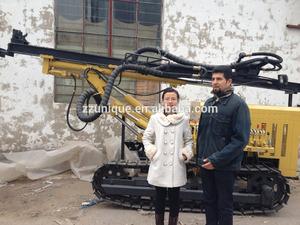(616 products available)










































































































































































































A bor machine is used for boring holes in a workpiece. These machines are used in woodworking, metalworking, and other industries. There are various types of bor machines for different purposes and workpieces.
They are also known as column bore machines. The main structure of the machine is a column or pillar. The column provides strong support and stability for the entire machine. The spindle is mounted on the column, and it moves up and down, allowing the machine to drill holes of different depths. The pillar bor machine is usually used for heavy-duty drilling tasks, and it can handle a wide range of workpiece materials.
The horizontal bor machine is a kind of bor machine that drills holes horizontally. It is similar to the vertical bor machine, but the spindle is oriented horizontally. Many horizontal bor machines also include a rotating worktable, which makes the machine suitable for drilling holes at various angles on the workpiece. Horizontal bor machines are ideal for drilling holes in long workpieces or for precise hole alignment requirements.
Multiple spindle bor machines are the most commonly used machines for woodworking. They are also known as line bore machines. They have multiple spindles that can simultaneously drill multiple holes in the workpiece. The distance between the spindles can be adjusted to meet different hole spacing requirements. Multiple spindle bor machines are efficient and suitable for batch processing of workpieces, such as drilling holes for shelves, cabinets, or furniture assembly.
Radial bor machines have a horizontal arm that can be moved up and down and rotated around the column. The spindle is mounted on the arm and can be easily positioned to drill holes in different areas of the workpiece. The radial bor machine is very flexible and suitable for drilling holes in large workpieces or irregularly shaped workpieces.
CNC (Computer Numerical Control) bor machines are controlled by a computer to accurately determine the position and depth of the holes to be drilled. They are equipped with advanced features, such as automatic tool changing and workpiece positioning. CNC bor machines are suitable for high-precision drilling tasks, such as making furniture, cabinetry, or precision machining parts.
Regardless of the type of machine or its size, the following specifications and maintenance tips can give a sense of what to expect when dealing with a bore machine.
Power source: Most bore machines are powered by electricity, hydraulics, or diesel. The power source must be specified to ensure compatibility with the machine's setup and the project requirements.
Max bore depth and diameter: These are very important specifications to consider. The bore machine's diameter indicates how wide a borehole or tunnel can be created. The depth shows the maximum depth the machine can drill to. These specifications should match the project requirements to avoid having to switch machines in the middle of a project.
Rod pull-back force and torque: This specification indicates the bore machine's ability to drill through different types of materials. The rod pull-back force helps to push and pull the drilling rods. The torque helps to rotate the drilling bit.
Drill head speed: This specification indicates how fast the drill bit can rotate. The speed will affect drilling efficiency and performance. The bore machine's operating speed should be carefully considered to ensure that it matches the project requirements.
Regular inspection: The machine should undergo a thorough check and inspection routinely. During the inspection, mechanical components, hydraulic system, electrical system, etc., should be looked at to ensure that everything is in working order and to catch potential problems early enough.
Lubrication: All moving parts of the machine must be well lubricated. This includes the drill head, the drill rods, the swivel head, and the carriage. This will help in minimizing wear and tear, ensuring smooth operation, and extending the machine's lifespan.
Cleaning: The bore machine should be well cleaned after use. Debris and mud should be removed from the machine's components to avoid corrosion and unnecessary damage.
By following these maintenance tips, the bore machine should remain efficient and reliable throughout its service life.
The boring machine is applicable in various sectors of the economy. Here are some common scenarios where the machine is used.
In the construction sector, the boring machine is used to create holes in the ground for various purposes. For instance, the machine can be used to drill holes for laying the foundation of a building. The machine can also be used to create holes for the installation of utility poles, such as electricity and street lighting poles.
The boring machine is used in the mining industry to extract minerals from the ground. The machine is used to create tunnels and shafts in the ground to gain access to mineral deposits. The machine can also be used to create ventilation shafts and access tunnels in mining operations.
The boring machine is used to construct infrastructure projects. For instance, the machine can be used to drill tunnels for roads, railways, and pipelines. The machine can also be used to create underground pathways for utilities such as water and sewage systems.
The boring machine is used in the manufacturing industry to create holes in workpieces. The machine is commonly used in the metal, woodworking, and construction industries. The machine is used to make precise holes in metal, plastic, and wood materials. It is also used to create accurate bores and cavities in the workpieces.
The boring machine is used in the geology industry for exploration and research purposes. The machine is used to extract soil and rock samples from the ground. The machine can be used to create boreholes and wells to study the composition of the earth. The machine is also used to install monitoring equipment and groundwater pumps.
When selecting a BOR machine, it is best to start by considering the intended application and material requirements. This will help to determine the type and model of the BOR machine that will meet specific business needs.
Assess the materials that the business will be working with to determine what kind of BOR is needed. Consider the thickness, type of material, and geometry. Also, consider the size of the business's typical workpieces. If they are generally large, it may be necessary to invest in a higher-capacity machine. The same applies to the frequency of use. If the BOR machine will be used frequently, then a more heavy-duty model is probably worth the investment.
Research the available models of the selected BOR type and compare their specifications. It is essential to consider the machine's power, capacity, and working range. Choose a model that can handle the business's current needs and provides some room for growth.
Assess the available space where the BOR machine will be located, taking into consideration not only the machine's footprint but also its clearance and access requirements for safe operation. Make sure the selected model will fit in the designated area and can be easily accessed from all sides for loading and unloading workpieces.
When selecting a BOR machine, it is necessary to consider the machine's safety features, including guarding, emergency stops, and safety interlocks. It is also important to ensure that operators receive proper training on how to use the machine safely. Finally, check the available budget and compare the prices of different models. Choose a BOR machine that offers good value for the investment by balancing performance, quality, and cost.
Q1 What is the difference between a horizontal boring machine and a vertical boring machine?
A1 The primary difference between a vertical borer machine and a horizontal borer machine is the orientation of the spindle. A vertical borer machine has a vertical spindle, while a horizontal borer machine has a horizontal spindle. They also perform different types of work and have different capabilities and functions.
Q2 Can a boring machine cut metal?
A2 Yes, a boring machine can cut through metal. The machine is usually manufactured with materials that can withstand heavy metal to allow the cutting of metal.
Q3 What is the difference between a drill and a boring machine?
A3 The primary difference between a drilling machine and a boring machine is the material removal technique. Drilling machines require a precise circular motion to cut through materials, while a borer machine uses multiple points to cut through materials.